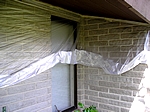How to Mask the Exterior of Your Home Professionally
Exterior paint masking presents different challenges when you compare it to masking off interior features. You will use many of the techniques used to mask interior surfaces. What you will have to mask is different. You don’t face bushes inside your home! Even if you decide to trim them back, you have to work around your landscape.
1) Gather Exterior Masking Materials
Drop Cloths
Drop cloths are going to be invaluable for protecting sidewalks, decks, plants, etc. Learn how to choose the right drop cloth for the job.
Tape
For most applications, you will either use the beige-colored crepe tape most of us know as masking tape or you will use blue painter’s tape which has a special adhesive that allows it to remain in place longer without becoming too difficult to remove. There is also a green brand available. All types of tape come in widths from 3/4″ to 2″.
Regular painter’s tape has a strong adhesive that attaches plastic or paper to most surfaces. Unfortunately for outdoor applications, exposure to sun or heat sets the adhesive so the paper shreds when you try to remove it.
Blue or green painter’s tape may cost more, but it can save you a lot of effort when it comes time to remove it.
Solvents and enamels dissolve the adhesives used in painter’s tape. If you are using an exterior oil based enamel to protect metal or other exterior surfaces, you will have to use a tape that is resistant to solvents to hold the masking material in place.
Paper and Plastic
Avoid the temptation to use newspaper. It disintegrates when it gets wet. For exterior applications masking paper and plastic are much better choices.
Masking paper comes in two types— brown kraft paper, good for latex paints, and green solvent resistant paper. Either can be a good choice for protecting a number of outdoor fixtures.
Plastic masking film is comes in several widths, from 24″ to 99″, making it easy to fit to popular window and door sizes. It is heavier than most general purpose plastic films, making it easier to handle.
Hand Held Masking Machine
A hand held masking machine can reduce masking time significantly. This machine makes it easy to apply paper or plastic by applying the tape to both the surface you want to mask and the masking material which can be either paper or plastic.
2) Decide What Needs to be Protected from Paint
You want to cover anything that you don’t want paint to get on. This means you’ll want to protect windows, doors, landscape plants, brick, deck floor and handrail, and sidewalks. Don’t forget about fixtures like water valves, phone and communication boxes, electrical meters and lights, etc.
3) Start Masking
Masking Sidewalks and Plants
Cover sidewalks, plants, and shrubs with heavy, rubber backed drop cloths or heavy canvas drop clothes. Rubber backing isn’t essential but does ensure that paint can’t seep through.
Masking Decks and Fences

For wood decks and other horizontal surfaces, place drop cloths a few inches from the house and use a masking machine and masking paper to cover the edge close to the house. Attach the paper to the drop cloth with wide tape. Do the same for fences and railings that attach to the house.
If you don’t take the time to cover everything with drop clothes, you’ll have two choices. Either sand and refinish or paint your deck and fence.
Masking Walls

Vertical walls can be masked the same way as interior surfaces. Just be aware that rough surfaces, like brick, masonry, and concrete, don’t allow painter’s tape to adhere well, especially if you haven’t brushed all the dirt and dust away. If possible, try to attach the tape to a painted surface. It is better to come back and cut in the areas that are against brick, masonry or concrete by hand.
Masking Windows and Doors
Cover windows and doors completely for the best results when undertaking exterior painting projects. Make sure tape holds down plastic or paper securely along all edges.
Masking Lights, Electric Meters and Other Outdoor Fixtures
Plastic and painters tape work well for most outdoor lights, electric meters and other outdoor fixtures you want to protect from paint. Garbage bags work very well. Use the size that’s closest to the size of the fixture you are covering.
In general it looks more professional to protect water valves, telephone boxes, etc. from paint, though in some cases you may decide that you prefer to paint these, especially if the color is going to clash with the color of your house.
Special Masking
Spray Painting
Tight seals and complete coverage of any surface you don’t want paint to get on is essential when spray painting. Overspray is impossible to control- especially outdoors, where it may be windy.
Quality of Materials
Using high quality paint, brushes, and rollers can help reduce splatters.


